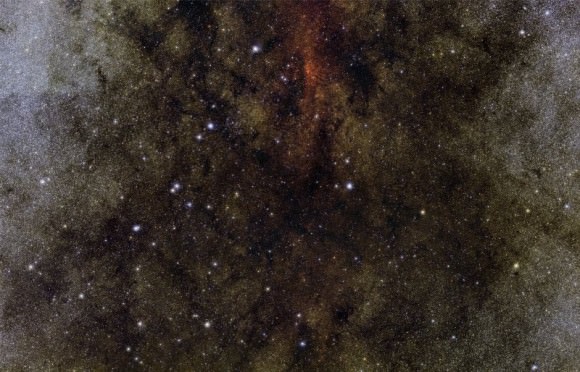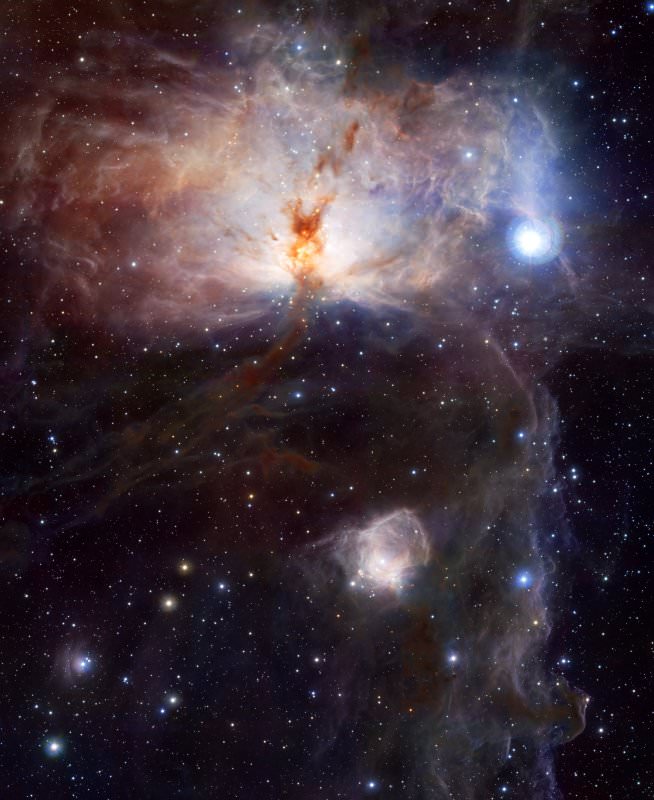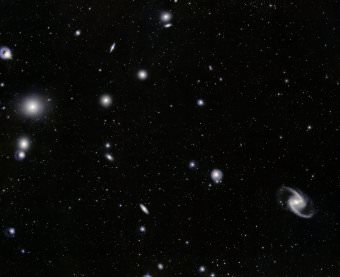Well, the WISE infrared all-sky satellite may be delayed until Monday, but the new infrared southern sky survey telescope VISTA (Visible and Infrared Survey Telescope for Astronomy) right here on Earth has gone online and released its first few gorgeous pictures.
This first one is of the Flame Nebula (NGC 2024), a star-forming region in the constellation Orion. The bright star in the image is the blue supergiant Alnitak, which is the easternmost star in Orion’s belt. Also shown is the reflected glow of NGC 2023 just below center, and the outline of the Horsehead Nebula in the far lower right (it looks a little different than you might normally see it because VISTA is operating in the visible and near-infrared). This image is about half the area of the full VISTA field of view, and is measures about 40 x 50 arcminutes – that’s about half a square degree on the sky , or twice the area of the full Moon.
The VISTA telescope is operated by the European Southern Observatory, and is part of their Paranal Observatory in the Atacama Desert of Northern Chile. It’s sitting just one peak over from the Very Large Telescope, also operated by the ESO. The main mirror on VISTA is a whopping 4.1 meters across (13.5 feet), and has 16 different detectors and a 3-ton camera for a total output of 67 million pixels. This allows for some very detailed images.
Since it’s a near-infrared telescope, it detects heat, and would detect its own heat signature, so the camera is housed in a cooler that keeps it at a chilly -200 degrees Celsius (-328 degrees Fahrenheit), and it’s sealed with the largest infrared-transparent window ever made. VISTA is charged with surveying the southern sky in the visible and near-infrared, and it will do so at a sensitivity that is forty times that of other infrared sky surveys, such as the Two Micron All-Sky Survey. It will be taking in enormous amounts of data to be processed: 300 gigabytes each night, or more than 100 terabytes per year.
Here’s a few more links to the first images released from the observatory to whet your appetite. Click on the links for a zoomable, hi-resolution image. You can be sure to see more like these in the future!
The Fornax Galaxy Cluster, including the barred-spiral galaxy NGC 1365 in the lower right, and the elliptical galaxy NGC 1399 to the left of it.
This image shows a dusty region with over one million stars near the heart of the Milky Way. The dust normally obscures the stars in visible light, but these stars are visible with the infrared eyes of VISTA.
Source: ESO



Just as with WISE, this near-infrared survey will lay the groundwork for further detailed observations by infrared space telescopes like Herschel and James Webb Space Telescope and large ground based observatories like the European Extremely Large Telescope. Unseen NEOs, nearby brown dwarf stars and massive distant galaxies and galaxy clusters lay on the horizon. This really is the golden age of astronomy.
My personal favorite ‘hidden delight’ here is in the Fornax Galaxy Cluster image. The big, roundish elliptical galaxy NGC 1399 is clearly seen surrounded by a swarm of globular clusters. This galaxy is known to have an unusually large number of globular clusters, probably as a result of galactic cannibalism.
D’ oh, NGC 1399 is the bright, round galaxy on the left hand side of the image.
Stunning results from an earth based scope and nice to see some first class European astronomy . Just think what one of these could see if it was on the moon.